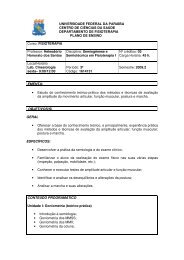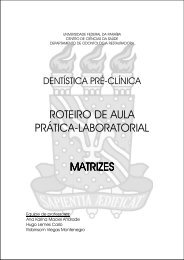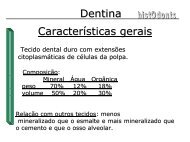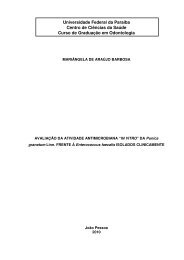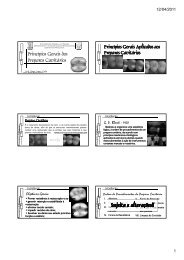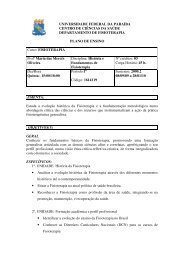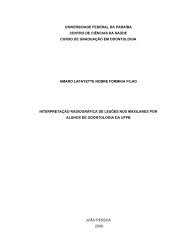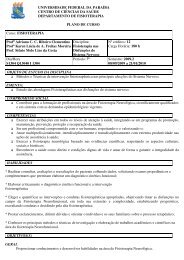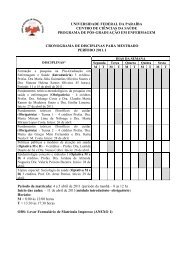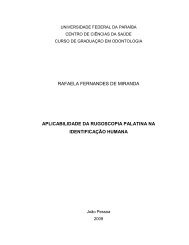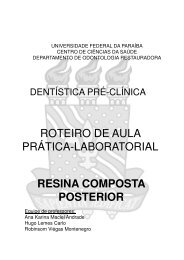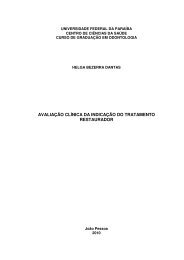10RESUMONa década <strong>de</strong> 50, a Organização Mundial <strong>de</strong> Saú<strong>de</strong> (OMS) estabeleceu as doençasbucais <strong>de</strong> interesse <strong>em</strong> Saú<strong>de</strong> Coletiva, sendo a cárie <strong>de</strong>ntária, as doençasperiodontais, más oclusões, câncer <strong>de</strong> boca e fissura labiopalatinas as <strong>de</strong> maiorprevalência. O presente estudo teve como objetivo avaliar as condições <strong>de</strong> <strong>higiene</strong> eestética <strong>de</strong>ntal <strong>das</strong> crianças/adolescentes do Programa <strong>de</strong> Erradicação do TrabalhoInfantil (PETI) da Comunida<strong>de</strong> Santa Clara, João Pessoa/PB. Para coleta <strong>de</strong> dadosfoi utilizado como técnicas a entrevista e o exame bucal para i<strong>de</strong>ntificação <strong>das</strong>condições <strong>de</strong> saú<strong>de</strong> e estética bucal <strong>das</strong> crianças e adolescentes baseando-se noManual da Equipe <strong>de</strong> Campo da Pesquisa Nacional <strong>de</strong> Saú<strong>de</strong> Bucal – SB Brasil2010. A amostra <strong>de</strong>ste estudo foi composta por 50 crianças/adolescentes na faixaetária <strong>de</strong> 07-15 anos, <strong>de</strong> ambos os gêneros, regularmente ativos no PETI. Os dadosforam submetidos a testes estatísticos <strong>de</strong> associação com nível <strong>de</strong> significância <strong>de</strong>5%. Os resultados mostram um alto índice <strong>de</strong> placa visível (IPV) e <strong>de</strong> Sangramentogengival (ISG), 97,3% e 83,3% respectivamente, mesmo to<strong>das</strong> as criançaspossuindo escova <strong>de</strong>ntal e relatando escovar os <strong>de</strong>ntes três ou mais vezes ao dia.Procuram o serviço público 97,7% <strong>das</strong> crianças, sendo a rotina o principal motivo daconsulta. A presença <strong>de</strong> más oclusões foi observada <strong>em</strong> 66,7% <strong>das</strong> crianças, nãohavendo associação entre o gênero. A presença <strong>de</strong> apinhamento foi observada <strong>em</strong>61,9%, espaçamento 54,7%, mordida aberta anterior <strong>em</strong> 7,2%, a relação molarnormal <strong>em</strong> 52,4% e o overjet maxilar, <strong>de</strong>ntre as anormalida<strong>de</strong>s <strong>de</strong> espaço e oclusãofoi a mais prevalente. Não foi observada relação entre o grau <strong>de</strong> escolarida<strong>de</strong> dospais e a má oclusão. Das crianças que apresentam má oclusão (66,7%), 45,2%relatam necessitar <strong>de</strong> algum tratamento, sendo o aparelho ortodôntico (35,7%) omais citado. Conclui-se que os participantes expressam baixa estima com a saú<strong>de</strong>bucal diante <strong>de</strong> um alto IPV e ISG. A elevada prevalência <strong>de</strong> alterações oclusais<strong>de</strong>monstra ser fundamental o reconhecimento <strong>das</strong> más oclusões como uma<strong>de</strong>manda importante que <strong>de</strong>va ser avaliada, não somente <strong>em</strong> relação à necessida<strong>de</strong><strong>de</strong> tratamento, mas também no que se refere às ações preventivas e educativas, asquais <strong>de</strong>v<strong>em</strong> ser cont<strong>em</strong>pla<strong>das</strong> na elaboração <strong>de</strong> um programa <strong>de</strong> saú<strong>de</strong> para estacomunida<strong>de</strong>.PALAVRAS-CHAVE: Saú<strong>de</strong> bucal; Oclusão <strong>de</strong>ntária; Epi<strong>de</strong>miologia
11ABSTRACTIn the '50s, the World Health Organization (WHO) established the oral diseases ofinterest in Public Health, <strong>de</strong>ntal caries, periodontal diseases, malocclusion, oralcancer and cleft lip and palate the most prevalent. This study aimed to evaluate thehygiene and aesthetics <strong>de</strong>ntal of children / adolescents Eradication of Child Labor(PETI) of the Santa Clara, Joao Pessoa / PB. For data collection techniques wasused as the interview and examination to i<strong>de</strong>ntify oral health and oral aesthetics ofchildren and adolescents based on the Manual of Field Team from the NationalSurvey of Oral Health - SB Brazil 2010. The sample comprised 50 children /adolescents aged 07-15 years, of both gen<strong>de</strong>rs regularly active in PETI. Data weresubjected to statistical tests of association with a significance level of 5%. The resultsshow a high rate of visible plaque (VPI) and gingival bleeding (GBI), 97.3% and83.3% respectively, <strong>de</strong>spite all children having toothbrush and brush your teethreporting three or more times a day. Seeking public service 97.7% of children, theroutine the main reason for visiting. The presence of malocclusion was observed in66.7% of children, there was no association between gen<strong>de</strong>r. Thepresence of crowding was observed in 61.9%, 54.7% spacing, anterior open bitein7.2%, the normal molar relation ship and overjet in 52.4% jaw, among theabnormalities of space and occlusion was the most prevalent. No relationship wasfound between the educational level of parents and malocclusion. Of children withmalocclusion (66.7%), 45.2% report needing some treatment, braces (35.7%) th<strong>em</strong>ost cited. We conclu<strong>de</strong> that the participants express low este<strong>em</strong> with oral health ona high IPV and ISG. The high prevalence of malocclusion <strong>de</strong>monstrates thefundamental recognition of malocclusion as a significant <strong>de</strong>mand that should bejudged not only on the need for treatment, but also with regard to preventive an<strong>de</strong>ducational actions, which should be reflected in <strong>de</strong>velopment of a health programfor this community.KEYWORDS: Oral Health; Dental Occlusion; Epi<strong>de</strong>miology
- Page 1: 1UNIVERSIDADE FEDERAL DA PARAÍBACE
- Page 4: 4M528aMelo, Marcelo Lucena de.Avali
- Page 7 and 8: 7AGRADECIMENTOSA toda minha famíli
- Page 9: 9“... Existem momentos que nunca
- Page 13 and 14: 13LISTA DE TABELASTabela 1. Distrib
- Page 15 and 16: 15LISTA DE FIGURASFigura 1. Associa
- Page 17 and 18: 17SUMÁRIO1. INTRODUÇÃO .........
- Page 19 and 20: 191 Introdução
- Page 21 and 22: 212003 revelaram um quadro insatisf
- Page 23 and 24: 232 REVISÃO DE LITERATURA2.1 PETI
- Page 25 and 26: 252.2 Levantamentos Epidemiológico
- Page 27 and 28: 27meio da Estratégia Saúde da Fam
- Page 29 and 30: 29superfícies dentais com placa vi
- Page 31 and 32: 31uma ocorrência de oclusopatias n
- Page 33 and 34: 33Apinhamento e espaçamento foram
- Page 35 and 36: 35observada em 60,4%, enquanto 34,5
- Page 37 and 38: 37Santos et al., (2007) em seu estu
- Page 39 and 40: 393 OBJETIVOSAvaliar as condições
- Page 41 and 42: 414 METODOLOGIAFoi utilizada a refe
- Page 43 and 44: 43a inclusão de seus filhos no nos
- Page 45 and 46: 454.4.1 Índice de Estética Dental
- Page 47 and 48: 473 OclusãoA oclusão é avaliada
- Page 49 and 50: 49Quadro 1. Códigos e critérios p
- Page 51 and 52: 51parede do tecido mole do sulco ou
- Page 53 and 54: 535 Resultados
- Page 55 and 56: 55100,0%80,0%60,0%83,33%97,61%40,0%
- Page 57 and 58: 57Tabela 4. Distribuição em núme
- Page 59 and 60: 59Tabela 6. Número e porcentagem e
- Page 61 and 62:
61Tabela 8. Relação entre os aspe
- Page 63 and 64:
636 Discussão
- Page 65 and 66:
65razão para se procurar o atendim
- Page 67 and 68:
67(2009) 1,6%, Utomi; Oyneaso (2009
- Page 69 and 70:
697 Conclusão
- Page 71 and 72:
71Referências
- Page 73 and 74:
73BRASIL. Ministério da Saúde. Pr
- Page 75 and 76:
75LUX, C. J.; DUCKER, B.; PRITSCH,
- Page 77 and 78:
77the Index of Orthodontic Treatmen
- Page 79 and 80:
79APÊNDICESAPÊNDICE A - TERMO DE
- Page 81 and 82:
81Ficha nº. _______APÊNDICE B - E
- Page 83 and 84:
83Os dentes duram a vida toda?Sim N
- Page 85 and 86:
85APÊNDICE D - FICHAS PARA EXAMES
- Page 87 and 88:
87ANEXOSAnexo 1Anexo 2
- Page 89:
89CARTA DE ANUÊNCIA 2UNIVERSIDADE



